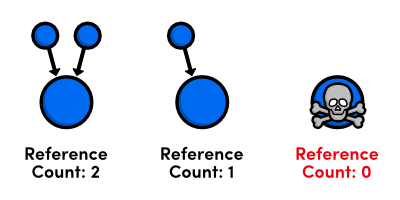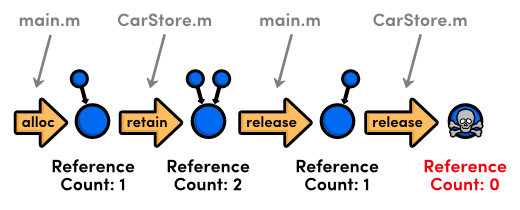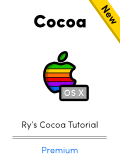You’re reading Ry’s Objective-C Tutorial |
Memory Management
As discussed in the Properties module, the goal of any memory management system is to reduce the memory footprint of a program by controlling the lifetime of all its objects. iOS and OS X applications accomplish this through object ownership, which makes sure objects exist as long as they have to, but no longer.
This object-ownership scheme is implemented through a reference-counting system that internally tracks how many owners each object has. When you claim ownership of an object, you increase it’s reference count, and when you’re done with the object, you decrease its reference count. While its reference count is greater than zero, an object is guaranteed to exist, but as soon as the count reaches zero, the operating system is allowed to destroy it.

In the past, developers manually controlled an object’s reference
count by calling special memory-management methods defined by the NSObject
protocol. This is called Manual Retain Release (MRR).
However, Xcode 4.2 introduced Automatic Reference Counting
(ARC), which automatically inserts all of these method calls for you.
Modern applications should always use ARC, since it’s more reliable and
lets you focus on your app’s features instead of its memory
management.
This module explains core reference-counting concepts in the context of MRR, then discusses some of the practical considerations of ARC.
Manual Retain Release
In a Manual Retain Release environment, it’s your job to claim and relinquish ownership of every object in your program. You do this by calling special memory-related methods, which are described below.
| Method | Behavior |
|---|---|
alloc |
Create an object and claim ownership of it. |
retain |
Claim ownership of an existing object. |
copy |
Copy an object and claim ownership of it. |
release |
Relinquish ownership of an object and destroy it immediately. |
autorelease |
Relinquish ownership of an object but defer its destruction. |
Manually controlling object ownership might seem like a daunting task, but
it’s actually very easy. All you have to do is claim ownership of any
object you need and remember to relinquish ownership when you’re
done with it. From a practical standpoint, this means that you have to balance
every alloc, retain, and copy call with
a release or autorelease on the same object.
When you forget to balance these calls, one of two things can happen. If you forget to release an object, its underlying memory is never freed, resulting in a memory leak. Small leaks won’t have a visible effect on your program, but if you eat up enough memory, your program will eventually crash. On the other hand, if you try to release an object too many times, you’ll have what’s called a dangling pointer. When you try to access the dangling pointer, you’ll be requesting an invalid memory address, and your program will most likely crash.

The rest of this section explains how to avoid memory leaks and dangling pointers through the proper usage of the above methods.
Enabling MRR
Before we can experiment with manual memory management, we need to turn off
Automatic Reference Counting. Click the project icon in the Project
Navigator, make sure the Build Settings tab is selected, and
start typing automatic reference counting in the search bar. The
Objective-C Automatic Reference Counting compiler option should
appear. Change it from Yes to No.

Remember, we’re only doing this for instructional purposes—you should never use Manual Retain Release for new projects.
The alloc Method
We’ve been using the alloc method to create objects
throughout this tutorial. But, it’s not just allocating memory for the
object, it’s also setting its reference count to 1. This
makes a lot of sense, since we wouldn’t be creating the object if we
didn’t want to keep it around for at least a little while.
// main.m#import<Foundation/Foundation.h>intmain(intargc,constchar*argv[]){@autoreleasepool{NSMutableArray*inventory=[[NSMutableArrayalloc]init];[inventoryaddObject:@"Honda Civic"];NSLog(@"%@",inventory);}return0;}
The above code should look familiar. All we’re doing is instantiating
a mutable array, adding a
value, and displaying its contents. From a memory-management perspective, we
now own the inventory object, which means it’s our
responsibility to release it somewhere down the road.
But, since we haven’t released it, our program currently has
a memory leak. We can examine this in Xcode by running our project through the
static analyzer tool. Navigate to Product > Analyze in
the menu bar or use the Shift+Cmd+B keyboard shortcut. This looks for
predictable problems in your code, and it should uncover the following in
main.m.

This is a small object, so the leak isn’t fatal. However, if it happened over and over (e.g., in a long loop or every time the user clicked a button), the program would eventually run out of memory and crash.
The release Method
The release method relinquishes ownership of an object by
decrementing its reference count. So, we can get rid of our memory leak by
adding the following line after the NSLog() call in
main.m.
[inventoryrelease];
Now that our alloc is balanced with a release, the
static analyzer shouldn’t output any problems. Typically, you’ll
want to relinquish ownership of an object at the end of the same method in
which it was created, as we did here.
Releasing an object too soon creates a dangling pointer. For example, try
moving the above line to before the NSLog() call. Since
release immediately frees the underlying memory, the
inventory variable in NSLog() now points to an
invalid address, and your program will crash with a EXC_BAD_ACCESS
error code when you try to run it:

The point is, don’t relinquish ownership of an object before you’re done using it.
The retain Method
The retain method claims ownership of an existing object.
It’s like telling the operating system, “Hey! I need that object
too, so don’t get rid of it!” This is a necessary ability when
other objects need to make sure their properties refer to a valid instance.
As an example, we’ll use retain to create a strong reference to our
inventory array. Create a new class called CarStore
and change its header to the following.
// CarStore.h#import<Foundation/Foundation.h>@interfaceCarStore:NSObject-(NSMutableArray*)inventory;-(void)setInventory:(NSMutableArray*)newInventory;@end
This manually declares the accessors for a property called
inventory. Our first iteration of CarStore.m provides
a straightforward implementation of the getter and setter, along with an
instance variable to record the object:
// CarStore.m#import"CarStore.h"@implementationCarStore{NSMutableArray*_inventory;}-(NSMutableArray*)inventory{return_inventory;}-(void)setInventory:(NSMutableArray*)newInventory{_inventory=newInventory;}@end
Back in main.m, let’s assign our inventory
variable to CarStore’s inventory property:
// main.m#import<Foundation/Foundation.h>#import"CarStore.h"intmain(intargc,constchar*argv[]){@autoreleasepool{NSMutableArray*inventory=[[NSMutableArrayalloc]init];[inventoryaddObject:@"Honda Civic"];CarStore*superstore=[[CarStorealloc]init];[superstoresetInventory:inventory];[inventoryrelease];// Do some other stuff...// Try to access the property later on (error!)NSLog(@"%@",[superstoreinventory]);}return0;}
The inventory property in the last line is a dangling pointer
because the object was already released earlier in main.m. Right
now, the superstore object has a weak reference to the array. To
turn it into a strong reference, CarStore needs to claim ownership
of the array in its setInventory: accessor:
// CarStore.m-(void)setInventory:(NSMutableArray*)newInventory{_inventory=[newInventoryretain];}
This ensures the inventory object won’t be released while
superstore is using it. Notice that the retain method
returns the object itself, which lets us perform the retain and assignment in a
single line.
Unfortunately, this code creates another problem: the retain
call isn’t balanced with a release, so we have another
memory leak. As soon as we pass another value to setInventory:, we
can’t access the old value, which means we can never free it. To fix
this, setInventory: needs to call release on the old
value:
// CarStore.m-(void)setInventory:(NSMutableArray*)newInventory{if(_inventory==newInventory){return;}NSMutableArray*oldValue=_inventory;_inventory=[newInventoryretain];[oldValuerelease];}
This is basically what the retain and the strong property
attributes do. Obviously, using @property is much more convenient
than creating these accessors on our own.

inventory
objectThe above diagram visualizes all of the memory management calls on the
inventory array that we created in main.m, along with
their respective locations. As you can see, all of the
alloc’s and retain’s are balanced with a
release somewhere down the line, ensuring that the underlying
memory will eventually be freed up.
The copy Method
An alternative to retain is the copy method, which
creates a brand new instance of the object and increments the reference count
on that, leaving the original unaffected. So, if you want to copy the
inventory array instead of referring to the mutable one, you can
change setInventory: to the following.
// CarStore.m-(void)setInventory:(NSMutableArray*)newInventory{if(_inventory==newInventory){return;}NSMutableArray*oldValue=_inventory;_inventory=[newInventorycopy];[oldValuerelease];}
You may also recall from The
copy Attribute that this has the added perk of freezing
mutable collections at the time of assignment. Some classes provide multiple
copy methods (much like multiple init methods), and
it’s safe to assume that any method starting with copy has
the same behavior.
The autorelease method
Like release, the autorelease method relinquishes
ownership of an object, but instead of destroying the object immediately, it
defers the actual freeing of memory until later on in the program. This allows
you to release objects when you are “supposed” to, while still
keeping them around for others to use.
For example, consider a simple factory method that creates and returns a
CarStore object:
// CarStore.h+(CarStore*)carStore;
Technically speaking, it’s the carStore method’s
responsibility to release the object because the caller has no way of knowing
that he owns the returned object. So, its implementation should return an
autoreleased object, like so:
// CarStore.m+(CarStore*)carStore{CarStore*newStore=[[CarStorealloc]init];return[newStoreautorelease];}
This relinquishes ownership of the object immediately after creating it, but
keeps it in memory long enough for the caller to interact with it.
Specifically, it waits until the end of the nearest
@autoreleasepool{} block, after which it calls a normal
release method. This is why there’s always an
@autoreleasepool{} surrounding the entire main()
function—it makes sure all of the autoreleased objects are destroyed
after the program is done executing.
All of those built-in factory methods like NSString’s
stringWithFormat: and stringWithContentsOfFile: work
the exact same way as our carStore method. Before ARC, this was a
convenient convention, since it let you create objects without worrying about
calling release somewhere down the road.
If you change the superstore constructor from
alloc/init to the following, you won’t have to
release it at the end of main().
// main.mCarStore*superstore=[CarStorecarStore];
In fact, you aren’t allowed to release the
superstore instance now because you no longer own it—the
carStore factory method does. It’s very important to avoid
explicitly releasing autoreleased objects (otherwise, you’ll have a
dangling pointer and a crashed program).
The dealloc Method
An object’s dealloc method is the opposite of its
init method. It’s called right before the object is
destroyed, giving you a chance to clean up any internal objects. This method is
called automatically by the runtime—you should never try to call
dealloc yourself.
In an MRR environment, the most common thing you need to do in a
dealloc method is release objects stored in instance variables.
Think about what happens to our current CarStore when an instance
is deallocated: its _inventory instance variable, which has been
retained by the setter, never has the chance to be released. This is another
form of memory leak. To fix this, all we have to do is add a custom
dealloc to CarStore.m:
// CarStore.m-(void)dealloc{[_inventoryrelease];[superdealloc];}
Note that you should always call the superclass’s dealloc
to make sure that all of the instance variables in parent classes are properly
released. As a general rule, you want to keep custom dealloc
methods as simple as possible, so you shouldn’t try to use them for logic
that can be handled elsewhere.
MRR Summary
And that’s manual memory management in a nutshell. The key is to
balance every alloc, retain, and copy
with a release or autorelease, otherwise you’ll
encounter either a dangling pointer or a memory leak at some point in your
application.
Remember that this section only used Manual Retain Release to understand the internal workings of iOS and OS X memory management. In the real world, much of the above code is actually obsolete, though you might encounter it in older documentation. It’s very important to understand that explicitly claiming and relinquishing ownership like this has been completely superseded by Automatic Reference Counting.
Automatic Reference Counting
Now that you’ve got your head wrapped around manual memory management, you can forget all about it. Automatic Reference Counting works the exact same way as MRR, but it automatically inserts the appropriate memory-management methods for you. This is a big deal for Objective-C developers, as it lets them focus entirely on what their application needs to do rather than how it does it.
ARC takes the human error out of memory management with virtually no downside, so the only reason not to use it is when you’re interfacing with a legacy code base (however, ARC is, for the most part, backward compatible with MRR programs). The rest of this module explains the major changes between MRR and ARC.
Enabling ARC
First, let’s go ahead and turn ARC back on in the project’s Build Settings tab. Change the Automatic Reference Counting compiler option to Yes. Again, this is the default for all Xcode templates, and it’s what you should be using for all of your projects.

No More Memory Methods
ARC works by analyzing your code to figure how what the ideal lifetime of
each object should be, then inserts the necessary retain and
release calls automatically. The algorithm requires complete
control over the object-ownership in your entire program, which means
you’re not allowed to manually call retain,
release, or autorelease.
The only memory-related methods you should ever find in an ARC program are
alloc and copy. You can think of these as plain old
constructors and ignore the whole object-ownership thing.
New Property Attributes
ARC introduces new @property attributes. You should use the
strong attribute in place of retain, and
weak in place of assign. All of these attributes are
discussed in the Properties module.
The dealloc Method in ARC
Deallocation in ARC is also a little bit different. You don’t need to
release instance variables as we did in The
dealloc Method—ARC does this for you. In addition, the
superclass’s dealloc is automatically called, so you
don’t have to do that either.
For the most part, this means you’ll never need to include a custom
dealloc method. One of the few exceptions is when you’re
using low-level memory allocation functions like malloc().
In this case, you’d still have to call free() in
dealloc to avoid a memory leak.
Summary
For the most part, Automatic Reference Counting lets you completely forget about memory management. The idea is to focus on high-level functionality instead of the underlying memory management. The only thing you need to worry about are retain cycles, which was covered in the Properties module.
If you need a more detailed discussion about the nuances of ARC, please visit the Transitioning to ARC Release Notes.
By now, you should know almost everything you need to know about Objective-C. The only thing we haven’t covered are the basic data types provided by both C and the Foundation Framework. The next module introduces all of the standard types, from numbers to strings, arrays, dictionaries, and even dates.
 |
Be sure to check out Ry’s Cocoa Tutorial. This brand new guide is a complete walkthrough of Mac App development, and it leverages all of the Objective-C skills that we just discussed. Learn more › |
Mailing List
Sign up for my low-volume mailing list to find out when new content is released. Next up is a comprehensive Swift tutorial planned for late January.
You’ll only receive emails when new tutorials are released, and your contact information will never be shared with third parties. Click here to unsubscribe.